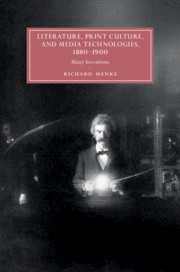Book contents
- Literature, Print Culture, and Media Technologies, 1880–1900
- Cambridge Studies in Nineteenth-Century Literature and Culture
- Literature, Print Culture, and Media Technologies, 1880–1900
- Copyright page
- Contents
- Figures
- Acknowledgments
- Introduction
- Chapter 1 A Message on All Channels
- Chapter 2 Fictions of the Victorian Telephone
- Chapter 3 New Media, New Journalism, New Grub Street
- Chapter 4 The Sinking of the Triple-Decker
- Chapter 5 Writers of Books
- Chapter 6 Words Fail
- Chapter 7 A Connecticut Yankee’s Media Wars
- After Words
- Bibliography
- Notes
- Index
- Cambridge Studies in Nineteenth-Century Literature and Culture
Chapter 7 - A Connecticut Yankee’s Media Wars
Orality and Obliteracy
Published online by Cambridge University Press: 30 September 2019
- Literature, Print Culture, and Media Technologies, 1880–1900
- Cambridge Studies in Nineteenth-Century Literature and Culture
- Literature, Print Culture, and Media Technologies, 1880–1900
- Copyright page
- Contents
- Figures
- Acknowledgments
- Introduction
- Chapter 1 A Message on All Channels
- Chapter 2 Fictions of the Victorian Telephone
- Chapter 3 New Media, New Journalism, New Grub Street
- Chapter 4 The Sinking of the Triple-Decker
- Chapter 5 Writers of Books
- Chapter 6 Words Fail
- Chapter 7 A Connecticut Yankee’s Media Wars
- After Words
- Bibliography
- Notes
- Index
- Cambridge Studies in Nineteenth-Century Literature and Culture
Summary
In Mark Twain’s A Connecticut Yankee in King Arthur’s Court (1889), the encounter between a skilled Yankee mechanic and the novel’s fanciful Middle Ages becomes a confrontation not simply between America and Britain, or between progress and stasis, but between oral and literate cultures. The novel’s perspective and even its origins bear out its connections to a late-nineteenth-century American anthropology that anticipated twentieth-century theories of orality and literacy. Twain’s own aspirations and experiences as a would-be new-media magnate, especially his sponsorship of James Paige’s mechanical compositor, inform his treatment of media history as a realm of antagonism and supersession. In the novel’s chilling final scene, techno-cultural rivalries expand into warfare and mass annihilation, a vision in which electricity and the Gatling gun figure as the doubles of the era’s new media technologies.
Keywords
- Type
- Chapter
- Information
- Literature, Print Culture, and Media Technologies, 1880–1900Many Inventions, pp. 158 - 186Publisher: Cambridge University PressPrint publication year: 2019

